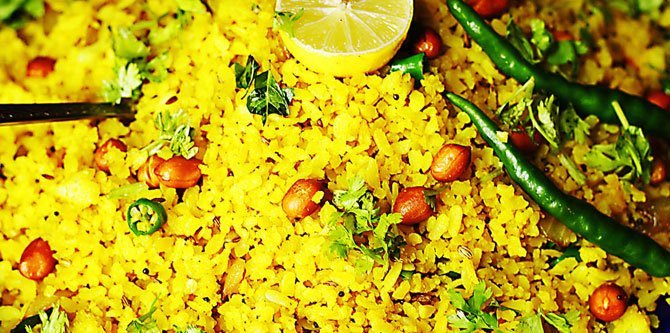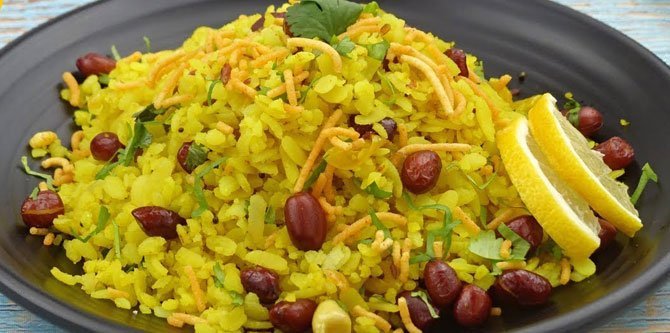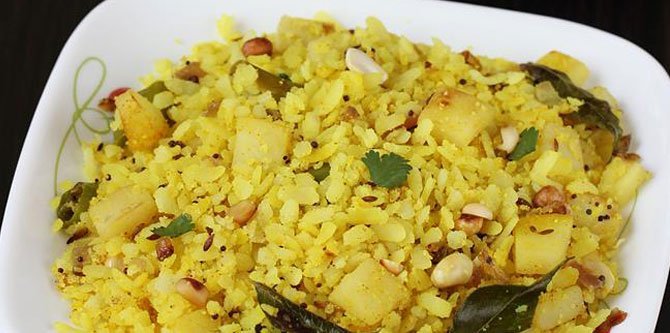Last Updated on August 18, 2020 by Dr Sharon Baisil MD
Diabetics are always on the search for innovative foods that will not only help them keep their blood sugar in range but also are appetizing to their taste buds.
Those who suffer from diabetes know just how different it is from all the other diseases. Unlike other metabolic disorders affecting the body, diabetes requires a complete lifestyle change — with the main focus on food.
So, have you ever wondered, is poha good for diabetes? It’s time to find the answer today!
Poha is a Gujarati dish mainly. Gujarat is known for its tempting sweet dishes. Most of their recipes involve usage of sugar.
But luckily, despite being a Gujarati food item, poha favors diabetic health. It won’t harm you till you are eating it in a considerable amount.
When the body is unable to control its glucose levels by itself, it is imperative that a diabetic must keep it in check; else there could be devastating circumstances.
With restrictions on sugary foods, beverages, and even some types of fats: What do diabetics really eat?
Diabetics should maintain the farthest distance from foods with a high glycemic index. But fear not, poha doesn’t have a high glycemic index score.
During diabetes, your body either fails to produce insulin or produces too little insulin that it fails to perform its functions properly. In both cases, glucose gets concentrated in the blood instead of reaching cells and problems begin.
The high levels of glucose in the blood can further rupture blood vessels, cause heart stroke, damage kidneys, and pose a serious threat to a person’s health.
Hence, once should be prepared right from the beginning. Leading a happy life along with diabetes is possible if you are watchful enough towards your food habits.
Following the same path, let us find out is poha healthy for diabetics or not.
What is Poha?

Poha, also called flaked rice, is a form of flattened rice, with a particular significance in Indian culture and history. Being a part of the Singham Literature belonging to the 6th century AD makes it one of the ancient foods passed along generations of the Indian population to this date.
Every flake of poha you see today was once a rice grain that was parboiled and then subjected to a series of rolling, flattening, and drying. These flakes are very thin, almost flat with the greyish appearance, and are very light in weight.
What makes Poha so popular amongst the Indian population is its ease of making and numerous benefits for digestion and health of a person.
Benefits of Poha:

Providing almost 200 calories per serving, the majority of which is carbohydrate and protein — Poha has the potential to complete one’s daily nutrient requirement in just 2 servings. Here are the 5 main benefits for Poha with respect to maintaining one’s health:
1. As an Energy Booster:
Providing 40 grams of carbohydrate per serving, Poha is an ideal breakfast which instantly fulfills your energy requirement and keeps you active throughout the day.
2. Provides Probiotic for the Stomach
Due to its method of preparation, Poha is an excellent source of probiotics to maintain your stomach health. The microorganisms formed from the fermentation process in Poha help protect our body from the action of harmful bacteria and viruses.
3. An Alternate Low-Calorie Diet
For those of us trying to lose weight, finding the right food is always tricky. By providing only 250 calories and a low-fat percentage per serving, Poha is an ideal weight-loss food. It could also be altered by adding dry fruits which will prolong the satiety levels throughout the day.
4. Rich Source of Iron for Pregnant Women
The method of its preparation involves using iron rollers to flatten the rice, which results in plenty of Iron being infiltrated into the flattened rice. This is particularly important for expecting mothers to prevent them from having Gestational Anemia and regulate their oxygen levels in the blood.
5. Easily Digestible
What makes Poha the perfect breakfast meal is that it is light on the stomach. With its ability to be easily digested, it can be used as the first meal of the day without causing any bloating or gut discomfort.
What You Need to Know About Diabetes
Although diabetes is a chronic disease with severe complications, it does not mean it cannot be controlled.
Type-2 diabetes also known as non-insulin-dependent diabetes is very different from diabetes type 1 in the sense that it is more prevalent in older and overweight individuals, as compared to type 1 which starts at a very young age.
The major difference between Type 1 and Type 2 diabetes is the Insulin Production of the body.
Although individual suffering from Juvenile Diabetes (Type 1) does not produce Insulin and require lifelong insulin injections to control their blood sugar, those suffering from type 2 diabetes can produce sufficient insulin in their body, but it is their cells which are unresponsive to it.
Hence these individuals do not require Insulin injections throughout their life and can control sugar levels just by controlling their diet.
Making small changes like taking certain foods out of your life while adding others can make a huge difference in the life of a Type-2 Diabetic.
Why Is Poha Beneficial for Diabetics?

With its weight-loss potential, ability to maintain a constant blood sugar level, and zero sugar content, Poha appears to be a potentially beneficial meal for diabetics.
It Prevents Further Weight Gain
Type 2 Diabetes is most commonly associated with overweight individuals; hence it is important to prevent further gain to keep one’s glucose levels in check.
In a chapter from her book, Alison Gray states:
“While the general principles discussed in the first section apply to all PWD, those people with type 2 diabetes who are overweight or obese (BMI 25.0 and greater) should have a major focus placed on weight loss and increased physical activity.”
Hence, being low in fat and high in fiber, Poha’s weight loss potential makes it particularly advantageous food for Diabetics struggling to lose weight.
It Helps Maintain Constant Blood Sugar Levels
Being a rich source of fiber by providing 2 grams per serving, Poha causes a slow but continuous release of sugar into the bloodstream preventing any sudden spike in the sugar levels.
This not only helps to keep the sugar levels in the blood steady but also keeps the person feeling full throughout the day. In turn, this prolonged satiety prevents a person — especially the elderly- from immediately going for something sweet when they feel hungry.
No Added Sugar
Containing no added sweeteners, Poha is usually cooked with chilies and seasonings and should be the ideal food for someone trying to control their glucose levels.
Gray emphasized in her book about the importance of limiting sweeteners for one’s health:
“People with diabetes should limit or avoid intake of sugar-sweetened beverages (SSBs) (from any caloric sweetener including high-fructose corn syrup and sucrose) to reduce the risk for weight gain and worsening of cardiometabolic risk profile.”
Is Poha Good for Weight Management?

Most of you might be unaware about the potential of poha as a weight loss assistant. Just because it is a form of rice, doesn’t mean it will have the same effect as rice on your body.
in fact, Poha is a good option when it comes to dieting.
We understand the struggles of people who go low-diet to shed extra belly fat. But dieting doesn’t mean you always have to sacrifice the taste. Not at least when poha is here!
Better weight management with better taste. Who wants more?
Beaten rice or poha is not only comfortable to digest but also keeps your stomach full for longer hours. Plus, the process of release of sugar into the bloodstream proceeds at slow rate that keeps your blood sugar levels under check.
Moreover, poha contains moderate calories. But make sure you don’t add potatoes as they are enemies of weight loss. Rather, just prepare your poha tossing in some onions, green chilies, peanuts, and basic spices. We guess this is enough to satisfy your taste buds.
If you are on a weight-loss routine, dietary fibers are excellent for the body during this situation. Flaked rice also provides much needed dietary fibers and prevents you from overeating.
Is Poha Healthy for Dinner?

According to nutrition experts, dinner must be the lightest meal of the day. This doesn’t mean it has to be boring always.
As long as you are sure that you are maintaining an adequate balance between carbohydrates, proteins, and fats in your diet, you can eat most of the things, including poha for dinner.
As poha is light on the stomach and assist in weight loss too, it can be safely eaten for a dinner. No problem is encountered when it comes to digesting Poha.
Eat it as a morning meal or as a dinner, blood sugars levels wouldn’t be influenced.
Is Poha Better Than Rice?
The very first difference you will notice between rice and flattened rice (poha) is thickness size. Rice grains are somewhat thick and become fluffy upon cooking. On the other hand, poha is flat and possesses no thickness. The grains are almost translucent and are not so fluffy after cooking.
To make poha from rice, it is parboiled. Does the term sound new? Let us clarify.
Parboiled rice is the one that is partially boiled before the husk is removed. It is much similar to brown rice in terms of nutritional profile. The major benefit received is that parboiled rice can be cooked with minimum oil, therefore favors good health and is a reservoir of myriads of nutrients.
There are a few aspects that make poha a better meal for diabetics;
- White is highly processed while poha is slightly processed.
- White rice contains fewer fibers than poha.
- Poha is weight-loss friendly but white rice is not.
- White rice is not as light as poha in terms of digestion.
- Poha is gluten-free, unlike white rice.
- Poha ranks low on the glycemic index while white rice ranks high on the same.
We have compared only between poha and white rice as other varieties like brown rice, red rice, black rice are also healthy food choices for diabetes.
How to Cook Poha or Flaked Rice?
Follow the given steps to cook a nutritious bowl of poha.
- Take the required quantity of flaked rice in a shallow vessel. Wash and rinse it twice. Make sure you drain all the water and your poha is rendered completely dry.
- Add some lemon to your poha and mix it thoroughly.
- Turn on the stove, place a pan on it, and pour the oil into it.
- Add mustard seeds once the pan gets hot enough.
- Then add onions, chilies, turmeric, and other spices sequentially.
- Finally, add poha soaked with lemon juice to the pan.
- You can sprinkle curry leaves as a garnishing element, curry leaves are good for diabetes as well.
Hurray! It’s time to relish your tasty bowl of poha.
In India, there are numerous recipes and ways to cook poha. Each state has its unique style to prepare this instant breakfast meal. Be it Kanda poha from Maharashtra or aval upma from south India, every recipe is mouth-watering as well as can be eaten guilt-free.
Final Thoughts
Although there are still mixed reviews about whether Poha is the ideal food for diabetics or not, almost all agree to its numerous benefits.
However, no matter how beneficial a thing might seem from reading about it somewhere — it does not make you immune to the harmful effects of overloading on it.
Moderation is the thing you need to work upon. It is key to live a healthy lifestyle.
Just like every food has its set of ingredients, every person has their unique chemistry with which they are created. A food which turns out advantageous for some might not be for others.
Hence, it is essential that someone with newly diagnosed or uncontrolled diabetes always keep their doctors in the loop while trying out new foods.
Rest everything assured, diabetics can conveniently eat poha and this light food isn’t going to harm them.
The silver lining is, diabetes can be controlled well through a combination of regular exercise, timely medications, and a healthy dietary plan. You need to be well-disciplined to follow a lifestyle that builds diabetes management strategy.
Reference:
https://www.ncbi.nlm.nih.gov/books/NBK279012/
https://pubmed.ncbi.nlm.nih.gov/25092385/
https://pubmed.ncbi.nlm.nih.gov/22422870/
https://pubmed.ncbi.nlm.nih.gov/31619642/
https://pubmed.ncbi.nlm.nih.gov/27253526/
https://pubmed.ncbi.nlm.nih.gov/31006420/
https://pubmed.ncbi.nlm.nih.gov/25590950/
https://pubmed.ncbi.nlm.nih.gov/31619613/





